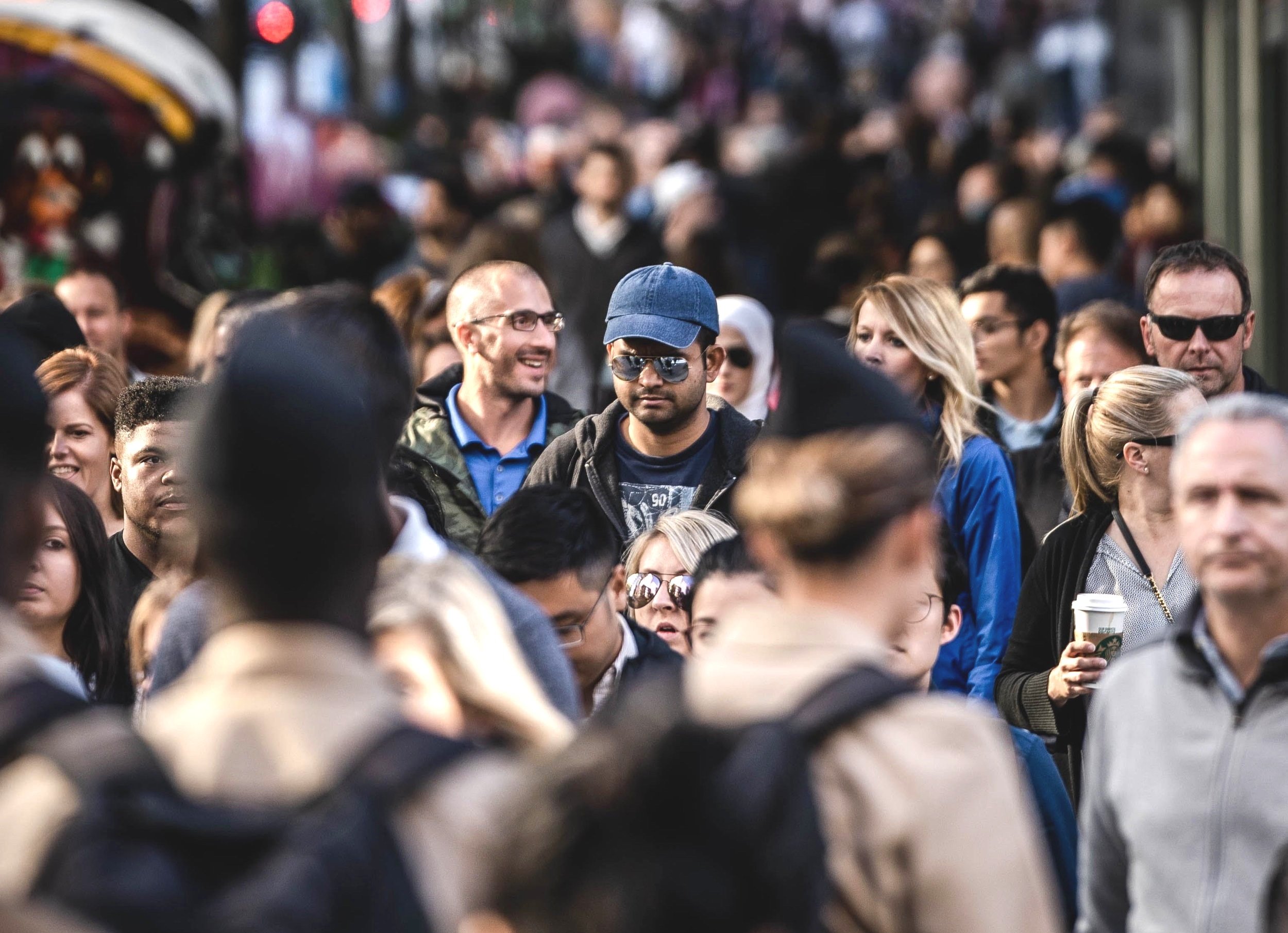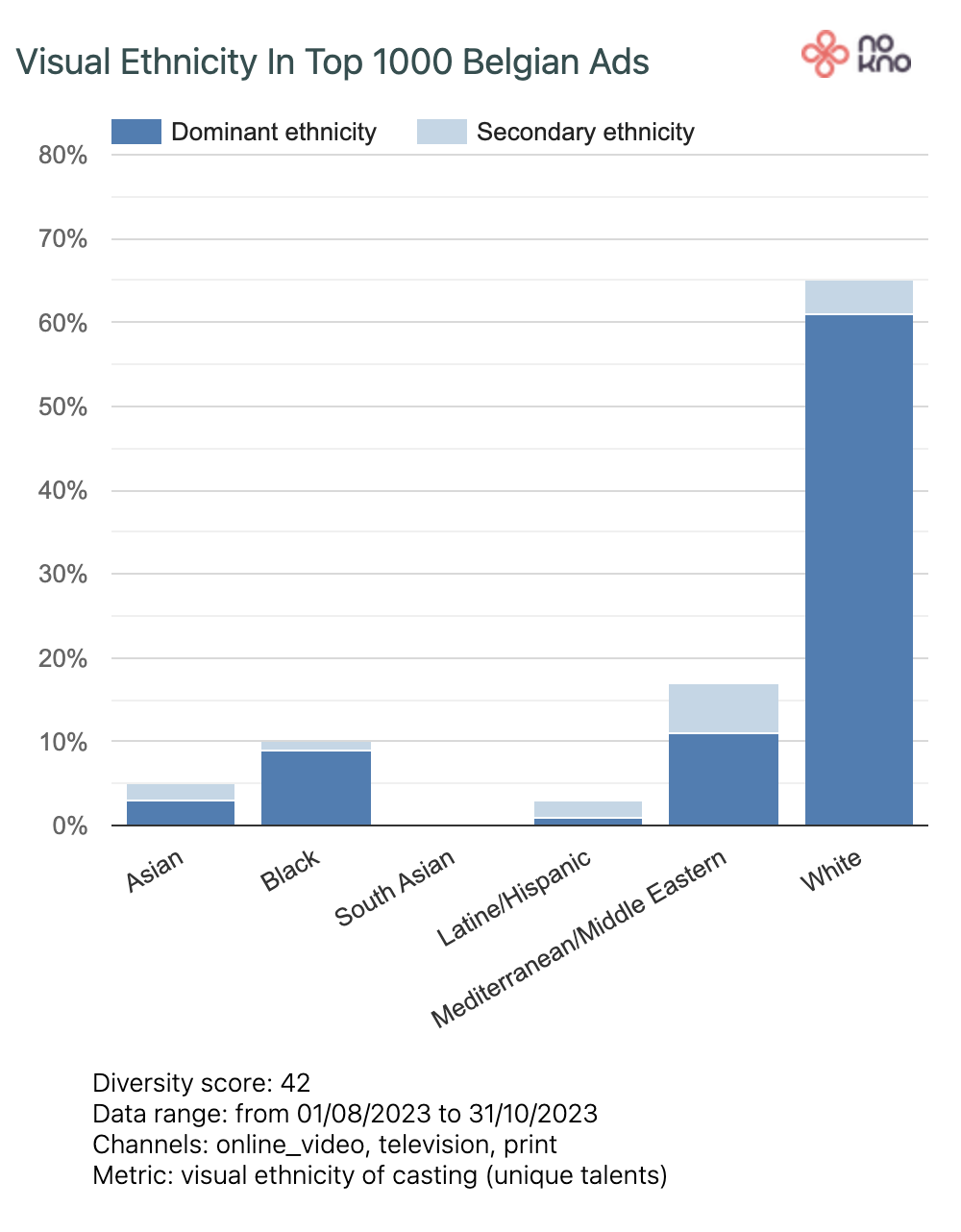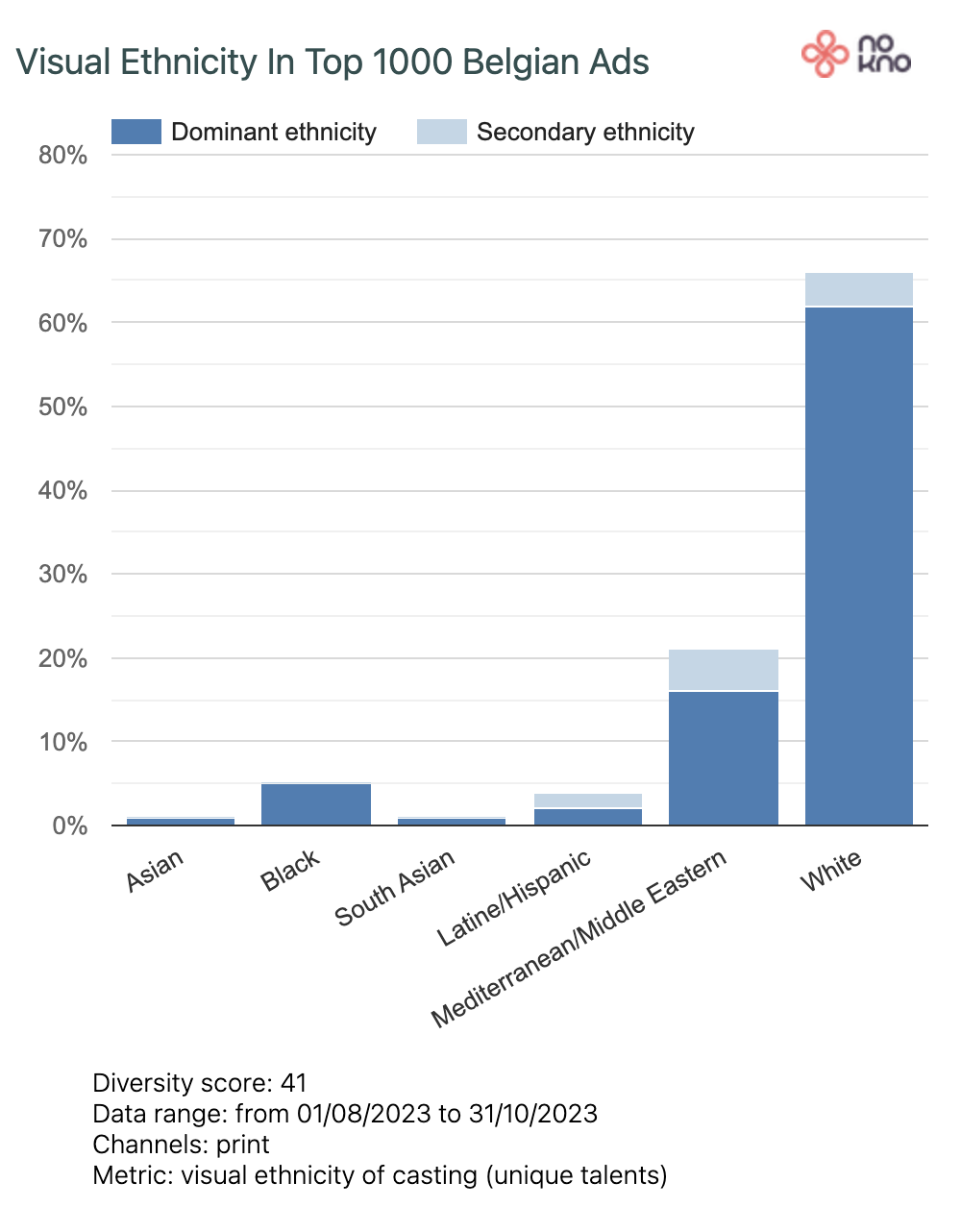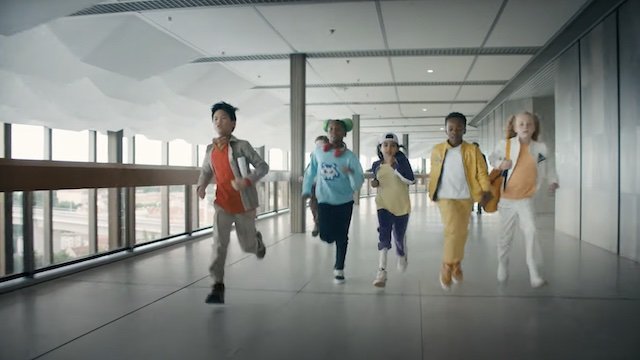
How diverse is Belgian advertising?
Are we making progress in representing society’s diversity and making it more inclusive? The Belgian Ad Diversity wants to help by measuring the diversity and representation of age, gender and ethnicity in Belgian advertisements.
Highlights
Each month we scan the top 1000 Ads of the top 100 Belgian Advertisers, measured by media spend. This page gives the highlights of the past 3 months.
The ads show a significant skew towards younger talents. Talents looking 45 years old and above account for only 19% of talents, while they represent 46% of the population and 53,5% of buying power.
On average, female talents are younger than male talents. Especially women above 45 are underrepresented.
82% of talents are perceived as White (White + Mediterranean/Middle Eastern) versus 18% non-White.
Ethnic diversity of locally aired advertisements is largely due to international TV ads. The categories with the most ethnic diversity are Automotive and Toys, using international campaigns. Ads from government and public services also score well in terms of ethnic diversity.
Retail, Telco, Energy, Finance and Insurance sectors, where local brands are strong, are increasing ethnic representation in their advertising. However, they are currently ranked middle of the pack.
Despite the body-positivity trend, we see mainly young talent in Beauty ads. Ads from government and public services represent (almost) all age groups equally.
The talent in online ads is younger, more female, and more ethnically diverse than in print ads. This seems to reflect their target audience. TV ads sit in the middle.
Overall, we can state that Belgian advertising makes efforts, but they are fragmented across media channels and sectors.
Check the detailed analysis per month
Marketers suffer from gerontophobia
It is no surprise that the age representation in advertising is significantly younger than the actual age of the Belgian population (green area).
The visual age distribution is centered around age groups 25-34 and 35-44 , good for 29% and 23% of all talent respectively. The next age group is -18, which accounts for 17% of talent. Age groups 18-24 and 45-54 are 13% and 11% respectively.
Talents looking 45 and above account for only 19% of talents, while they represent 46% of the population and 53,5% of buying power.
Obviously advertising is always aspirational and a 50-year old may feel represented by a 40-year old, but there's a limit to this flexibility.
Age representation across different channels
Representation of age varies depending on the medium. The age groups represented in advertisements are getting progressively older from online ads to TV ads to print advertisements. This indicates that advertisers represent similar-aged people as the target audiences that those specific media channels reach.
Online
Television
Ladies first, especially online
We do acknowledge that gender is not simply a binary attribute determined by appearance. However, our computer vision algorithm used to analyse the Top 1000 ads categorises people based on their facial features as either male or female.
According to our analysis 45% of the talent looks male and 55% looks female.
Gender representation across different channels
In addition to a change in age, we also see a shift in gender in different media. In online ads 59% of depicted persons are women, in TV ads 56% and in print ads 51%. Online ads show younger and more female talent, while print ads show older and more gender-balanced talent. Over the last 3 months, we've seen this trend consistently.
Old cattle and young grass
On average, female talents are younger than male talents when we cross visual age and visual gender.
We can observer that the largest male age group is 35-44, while the largest female age group is 25-34. As the talent gets older, we see less female talent, as they get younger we see more female talent.
This trend was consistent over the last 3 months. And it is consitent with reports from the media and film industry.
| Age | Male | Female | delta % |
|---|---|---|---|
| +65 | 35 | 12 | 49% |
| 55-64 | 121 | 54 | 38% |
| 45-54 | 183 | 108 | 26% |
| 35-44 | 319 | 303 | 3% |
| 25-34 | 313 | 484 | -21% |
| 18-24 | 108 | 240 | -38% |
| -18 | 148 | 305 | -35% |
Age x Gender of casting in Top 1000 Ads
Ethnic diversity
Diversity in advertising has received a lot of attention since the Black Lives Matter Movement. The Belgian advertising industry has made great strides, although not all sectors are at the same level. A lot of the diversity in locally aired advertisements comes from internationally produced TV ads.
Our analysis shows that 82% of talents are perceived as White (White + Mediterranean/Middle Eastern) versus 18% non-White. 10% of the talents are perceived as Black, while 5% are perceived Asian.
The data model used will predict the probability of a talent belonging to an ethnic/race group based on facial features. Since the boundaries between ethnic/race groups are not hard, a talent can be perceived as having a dominant and a secondary ethnicity/race.
The model detects two kinds of White: White (lighter) and Mediterranean/Middle Eastern (darker), next to Black, Asian, South Asian (e.g. India, Pakistan) and Latine/Hispanic.
Belgium is a very ethnically diverse country: 33% of the population comes from migration backgrounds (first or second generation). 16,1% have an EU migration background, while 17,3% have a non-EU migration background. As Belgium does not report detailed ethnic data, it is difficult to determine if the ethnic representation in the barometer is representative of the population. In general, we can say that diversity in ads and diversity in society are of the same magnitude.
Ethnic diversity across channels
Furthermore, ethnic diversity varies across generations in addition to the uneven geographical spread. The percentage of people with migration backgrounds may be less than 10% in older generations, while it may reach more than 50% in younger generations in inner cities. Different advertising channels reflect this trend. Online ads, which frequently target younger generations, show more ethnic diversity than print ads, which typically target older people.
Online
Television
Seasonality? Or are we dropping the ball?
There has been a decline in ethnic diversity in ads over the last three months. The share of lighter White persons increased from 59% in August to 67% in September to 69% in October. The share of Mediterranean/Middle eastern looking talents dropped from 22% to 14% to 13%. Black representation hovered around 10%, ending in 9% in October. Asian representation was 5% and ended up 6% in October.
Thus, it is mainly the share of Mediterranean/Middle Eastern looking talent that has dropped. Our analysis revealed that a handful of sectors were responsible for representing most of the Mediterranean/Middle looking talent. There were a lot of summer festivals and events advertised in Media and Event ads in August. These ads featured artists and audiences similar to the diversity of the Belgian population. In addition, Soft Drink ads, which are international productions featuring diverse talent, also contributed to increased ethnic diversity. These three categories stopped advertising in September, which caused the main drop in diversity.
August 2023
September 2023
October 2023
Comparing sectors
Diverse representation varies by sector. As some sectors target specific age groups or genders, this is not surprising. Beauty products, for example, are typically targeted at women. However, targeting cannot explain all differences.
The diversity award goes to … Government and Public Services
With recycling campaigns, ecological subsidies, army recruitment and science and mobility projects, the Government and Public Sector score the highest at representing (almost) all age groups. The sector ranks 3rd when it comes to ethnic diversity. The sector is slightly skewed towards representing men however. Overall the Government and Public Sector ads show the highest diversity.
Nominees
Age representation
Government
Health and Pharma
Tied 3rd place: Telco and Energy, Distribution and Retail, Media and Publishing
Advertisers who reach the whole population and are not overly obsessed with youth are the most age-diverse.
In this sense, the Beauty sector is (un)surprising. Despite the body-positive trend, they mostly show young talent.
Gender representation
Cleaning products
Appliances and electronics
Tied 3rd place: Hospitality (Horeca), Food and Drinks
Women will be happy to learn that there are as many men as women shown in Cleaning Products ads. Whether this translates into men doing more household cleaning remains to be seen.
Ethnic representation
Automotive and transportation
Toys and events
Government
Internationally produced TV ads dominate the Automotive and Toys categories. There is a noticeable difference in ethnic diversity representation between international and local brands. There is clearly a trend toward more ethnic representation in sectors where local brands are strong, such as Retail, Telco, Energy, Finance and Insurance. However, they are currently ranked middle of the pack when it comes to ethnic representation in their ads.
In-depth analysis
Check out the monthly in-depth analysis, for more details and more info on sectors.
Check detailed analysis per month
Methodology
If you have questions about the methodology or the technology used to create the Belgian Ad Diversity Barometer, check our methodology page.




















